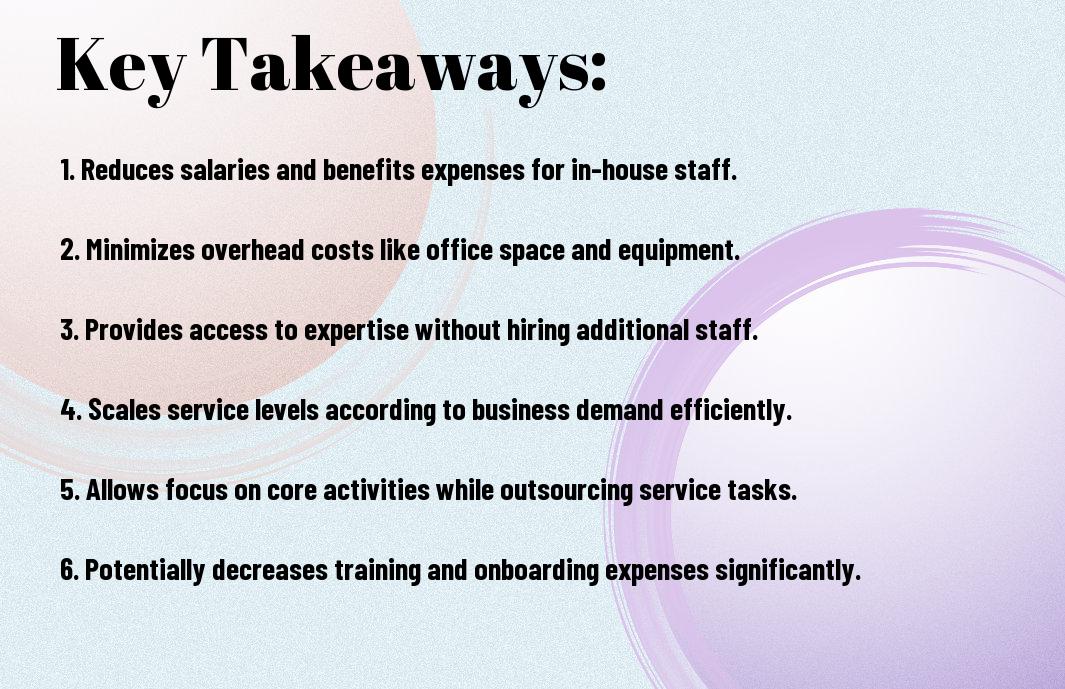Outsourcing customer service can significantly lower staff costs while maintaining high-quality support for your business. By leveraging external providers, you can eliminate expenses associated with hiring, training, and managing an in-house team. This strategy allows you to focus your resources on core business activities, ultimately enhancing productivity. Outsourcing also offers flexibility in scaling operations as your business needs change, reducing the financial risks associated with fixed staffing levels. With these benefits in mind, exploring outsourcing as a viable option can lead to significant cost savings and improved service delivery for your customers.
Key Takeaways:
- Outsourcing customer service can lead to significant savings on salaries and benefits by utilizing third-party companies that often have lower operational costs.
- By outsourcing, businesses can scale their support teams according to demand without the fixed costs associated with hiring and training full-time staff.
- Outsourcing customer service allows companies to focus on core business activities, enhancing efficiency and potentially leading to increased profitability.
Understanding Customer Service Outsourcing
To improve efficiency and reduce costs, many businesses are looking into outsourcing their customer service operations. This practice involves delegating customer support tasks to third-party organizations, which can offer a range of services tailored to meet your specific needs. By doing so, you can focus on core business activities while trusted external partners handle interactions with your customers. If you’d like to learn more about the advantages of this approach, check out How Outsourcing Customer Service Reduces Operational Costs.
Definition and Core Concepts
For businesses considering this path, it’s vital to understand the fundamentals of customer service outsourcing. It typically involves engaging a specialized firm to manage your customer interactions, whether through calls, emails, or online chat. This arrangement allows you to leverage the expertise of service providers who employ skilled agents and advanced technologies to enhance customer satisfaction.
Types of Customer Service Outsourcing Models
Understanding the different models of customer service outsourcing can empower you to choose the best fit for your business. Here’s a breakdown of some common models:
| Model | Description |
| In-house Outsourcing | Utilizing a dedicated team within your company for customer service. |
| Offshore Outsourcing | Partnering with a foreign service provider to cut costs. |
| Nearshore Outsourcing | Collaborating with companies in neighboring countries for better time zones. |
| Onshore Outsourcing | Employing domestic firms to handle your customer services. |
| Cloud-based Outsourcing | Using cloud technology for scalability and flexibility in customer support. |
Customer service models also range in the degree of control that you maintain and the level of integration with your existing processes. You may opt for a full-service provider that handles every aspect of customer interaction or select a model that complements your in-house efforts.
- In-house Outsourcing offers greater control over customer experiences.
- Offshore Outsourcing provides cost savings, often at the expense of communication barriers.
- Nearshore Outsourcing can offer a balance between cost and cultural alignment.
- Onshore Outsourcing typically allows for easier management and potentially higher service quality.
- Cloud-based Outsourcing enhances flexibility and access to technology.
The selection of an outsourcing model requires careful consideration of your business needs, the potential for growth, and the quality of service expected from third-party providers.

Cost Analysis of In-House vs. Outsourced Customer Service
The decision to manage customer service in-house or outsource it can have significant financial implications for your business. You need to assess direct labor costs, which include salaries, benefits, and training expenses for your customer service team. In-house teams typically require a strong investment in human resources, from recruiting the right personnel to ongoing employee development. On the other hand, when you outsource, you gain access to skilled professionals without the burden of employee-related costs, potentially allowing you to allocate resources more effectively.
Direct Labor Costs and Benefits
Along with direct labor costs, you must consider the benefits associated with your customer service operations. In-house teams may offer better knowledge of your products and company culture, leading to a more personalized interaction with customers. However, the costs of hiring and maintaining this expertise can escalate rapidly, especially for small to mid-sized businesses, where every penny counts. Outsourcing can present a more appealing structure, providing expertise at a reduced expense, helping you to maximize efficiency.
Infrastructure and Technology Expenses
Expenses related to infrastructure and technology also play a pivotal role in the cost analysis between in-house and outsourced customer service. When you opt for an in-house approach, you will need to invest in physical workspace, communication tools, and software to support your customer service activities, which can be a substantial ongoing cost. Conversely, outsourcing allows you to leverage the technology and infrastructure already established by the service provider, which usually translates into lower overall expenses for your company.
Understanding the implications of infrastructure and technology expenses can significantly impact your overall budget. By outsourcing customer service, you eliminate the need for constant upgrades to software and hardware, as the service provider manages these aspects for you. In addition, you also have the advantage of flexibility; you can easily scale your needs up or down based on your business demand without the headaches of adjusting in-house resources. Consequently, this strategic shift can lead to cost savings while maintaining quality service for your customers.

Financial Benefits of Customer Service Outsourcing
Keep in mind that outsourcing your customer service can lead to significant financial benefits for your organization. Many businesses face mounting operational costs, which can affect their profitability. By outsourcing, you can take advantage of specialized providers who can often deliver the same quality of service, or even better, at a lower cost. Outsourcing allows you to shift fixed costs to variable costs, meaning you only pay for the services you need, when you need them. This approach mitigates the burden of overhead expenses linked with in-house customer service teams, such as salaries, benefits, workspace, and training.
Operational Cost Reduction
Around the globe, many companies have seen their operational expenses dramatically decrease after outsourcing customer service functions. When you partner with a dedicated customer service provider, you typically eliminate the need for extensive staff training and ongoing management, which can be both time-consuming and expensive. Additionally, outsourcing enables you to take advantage of lower labor costs in other regions while accessing specialized expertise. This strategic move can enhance your cost structure and improve overall efficiency in your operations.
Scalability and Flexibility Advantages
After outsourcing your customer service, you’ll find that scalability and flexibility become prominent advantages. As your business grows or experiences fluctuations in demand, outsourced providers can quickly adjust the level of service they provide to align with your current needs. This allows you to easily scale up during peak periods, maintaining high customer satisfaction without incurring unnecessary costs during quieter times. Your ability to adapt to changing market conditions becomes a strength rather than a challenge, allowing you to focus on growing your business.
It is imperative to recognize that being able to easily ramp up or down your customer service capabilities without significant investments in staffing or infrastructure provides a strategic edge. By leveraging outsourced customer service, you maintain control over operational expenditures while ensuring you can address customer needs promptly. This adaptability can lead to improved customer satisfaction and loyalty, translating into increased revenue potential. Outsourcing provides you with a robust framework that can effortlessly grow with your business, enhancing your overall agility in the marketplace.
Hidden Cost Savings
For many businesses, outsourcing customer service can unearth significant hidden cost savings that go beyond the obvious reductions in payroll expenditures. When you choose to utilize external service providers, you alleviate the financial burden associated with maintaining a dedicated in-house team. This means that you can divert your available resources towards strategic initiatives that drive growth, while also enjoying the flexibility of scaling customer service operations based on consumer demand. As you consider the overall expenses of managing your customer service, you may find that outsourcing allows you to eliminate costs tied to employee benefits, office space, and utilities.
Training and Development Expenses
An often-overlooked aspect of maintaining an in-house customer service team is the investment in training and development. You may find that continuous training programs are necessary to keep your employees informed of product updates, service techniques, and industry standards. By outsourcing, you align with providers who already have established training protocols and experienced personnel. This can save you from the costs associated with developing your own training materials and conducting workshops, allowing you to focus on enhancing your core business functions.
Administrative and Management Overhead
For many organizations, the administrative and management overhead tied to an in-house team can quickly accrue and strain your operational budget. You could be looking at expenses that encompass recruitment, payroll processing, office supplies, and management supervision, adding layers of complexity that take you away from your primary objectives. By outsourcing your customer service, you effectively eliminate the need for these administrative tasks, granting you greater freedom to allocate funds toward revenue-generating activities. Additionally, outsourcing gives you access to a team of professionals who handle these responsibilities more efficiently, streamlining your operations while potentially enhancing customer engagement.
Cost savings from outsourcing are evident as you reduce the need for full-time management oversight in customer service. Instead of dedicating resources to hiring and training managers, you work with a service provider who specializes in optimizing these functions, often at a lower cost than maintaining your own team. With outsourcing, you can shift your focus back to your strategic goals and innovation, confident that your customer service is being managed adeptly without the added financial strain.

Quality Considerations in Cost-Effective Outsourcing
Once again, it is crucial to recognize that while outsourcing can significantly reduce your staff costs, it does not come without its own set of challenges, particularly regarding quality. When moving to an outsourced model, you must ensure that the quality of your customer service remains high to avoid potential damage to your brand reputation. This involves selecting the right outsourcing partner who can meet your quality standards and align with your overall company goals. Properly managing these relationships involves regular assessments and continuous improvements to ensure that service levels meet your expectations.
Performance Metrics and Standards
By establishing clear performance metrics and standards for your outsourced customer service teams, you can effectively monitor service quality while keeping costs in check. Metrics such as average response time, resolution rates, and first-contact resolution can provide valuable insights into the performance of your outsourcing partner. It’s important that these metrics are regularly reviewed and adjusted as necessary, ensuring that you are maintaining service that is not only cost-effective but also meets the demands of your customers.
Customer Satisfaction Balance
With the growing importance of customer satisfaction in today’s competitive market, achieving a balance between cost reduction and quality service is paramount. It’s crucial to put processes in place that allow you to measure customer feedback and satisfaction levels consistently. Investing in a quality training program for your outsourced staff will enhance their ability to provide excellent service, thereby creating a better experience for your customers without significantly increasing costs.
Considering the direct link between customer satisfaction and your business’s success, outsourcing customer service requires a strategic approach to maintaining that satisfaction level. By focusing on effective training, performance metrics, and feedback loops, you can empower your outsourcing partner to deliver high-quality service. This way, you’ll not only reduce your staff costs but also ensure that your customers remain engaged and satisfied with their experiences, which can lead to increased loyalty and long-term growth. Neglecting this balance can lead to negative reviews and decreased customer loyalty, underscoring the importance of a proactive approach to quality management in outsourcing.
Implementation Strategies
Despite the numerous benefits that outsourcing customer service can bring to your organization, the implementation of such a strategy must be carefully planned to ensure a smooth transition. Firstly, conducting a thorough assessment of your current customer service processes is necessary. This includes identifying areas that need improvement and determining which customer service functions are most suitable for outsourcing. You will also need to establish key performance indicators (KPIs) that align with your overall business objectives, allowing you to effectively measure the success of the outsourced operation. A well-defined plan will not only help you manage the transition but will also instill confidence in your internal team during the process.
Transition Planning
Among the many considerations to address during the transition phase, clear communication with your staff is paramount. You will need to inform your team about the changes taking place and emphasize the reasons behind your decision to outsource. Engaging your employees in the process can help alleviate fears about job security and demonstrate how this move can provide opportunities for professional growth within the company. Additionally, you should collaborate closely with your outsourcing partner to ensure an understanding of your brand’s values and customer service approach, which will ultimately create a seamless experience for your customers.
Risk Management and Cost Control
About managing risks during this transition, you must be proactive in identifying potential challenges that could arise from outsourcing your customer service. One of the main risks involves communication barriers, particularly if your outsourcing partner operates in a different time zone or speaks a different language. To mitigate this risk, it’s necessary to establish clear channels of communication and set expectations regarding response times and issue resolutions. Additionally, implementing quality control measures will help ensure that the level of customer service remains high, aligning with your company’s standards and customer expectations.
Indeed, effective risk management and cost control can significantly influence the success of your outsourced customer service strategy. By monitoring expenses and analyzing data from your KPIs, you can identify areas for improvement and adjust your approach as needed. Engaging with your outsourcing partner to discuss performance and setting up regular reviews will allow you to remain aware of any potential issues before they escalate. Ultimately, the right measures in place will enable you to not only manage risks efficiently but also optimize costs, ensuring the sustainability of your customer service operations.
Final Words
Upon reflecting on the benefits of outsourcing customer service, you may realize that this strategic move holds the potential to significantly reduce your staff costs while enhancing service quality. By reallocating functions to specialized providers, you not only save on employee expenses such as salaries, benefits, and training but also gain access to advanced technology and expert staff. This can elevate your overall customer experience, allowing you to focus on core business activities and further innovate your services.
Additionally, outsourcing customer service can provide you with the flexibility to scale your operations according to demand, which means you can avoid the costs associated with hiring and laying off staff during peak and off-peak periods. For those looking to explore these opportunities more thoroughly, you can Outsource Customer Service | Discover the benefits of … to help you make an informed decision. Embracing this practice can lead to a leaner operation and greater profitability in your business, providing you with a competitive edge in your industry.
Q: How does outsourcing customer service lead to cost savings for a business?
A: Outsourcing customer service can lead to cost savings for a business in several ways. First, it eliminates the need for a dedicated in-house team, reducing payroll expenses such as salaries, benefits, and training costs. Instead, businesses can hire external service providers who often have established operational efficiencies, allowing them to deliver services at a lower rate. Additionally, outsourcing provides scalability; businesses can adjust service levels according to demand without the financial burden of hiring or laying off staff.
Q: What are the indirect cost savings associated with outsourcing customer service?
A: Beyond direct labor savings, outsourcing customer service can lead to several indirect cost reductions. By engaging specialized firms, businesses can benefit from technological investments that the outsourcing partner has already made, such as advanced customer relationship management systems or analytics tools. This reduces the need for businesses to invest in expensive technology. Furthermore, outsourcing can enhance focus on core business activities, allowing internal teams to concentrate on strategic initiatives that drive revenue, ultimately supporting overall financial performance.
Q: Are there any risks involved in outsourcing customer service that might affect cost savings?
A: While outsourcing customer service can significantly lower costs, there are potential risks that can affect overall savings. Communication barriers or cultural differences can result in misunderstandings and lower customer satisfaction if not managed properly. If the service quality declines, it could lead to customer attrition, negatively impacting the business’s bottom line. Additionally, there may be hidden costs related to managing the outsourcing relationship, which can eat into savings. It’s crucial for businesses to carefully vet outsourcing partners and implement strong management practices to mitigate these risks.
